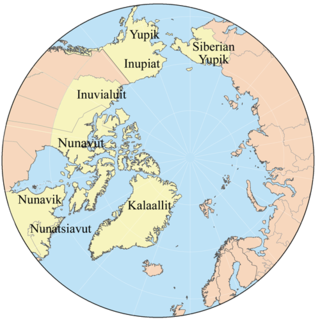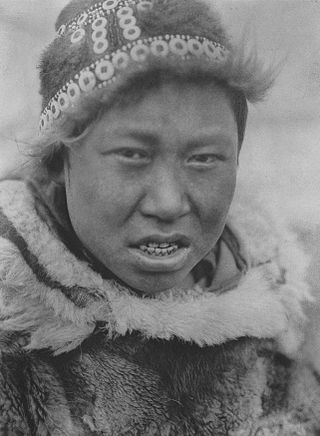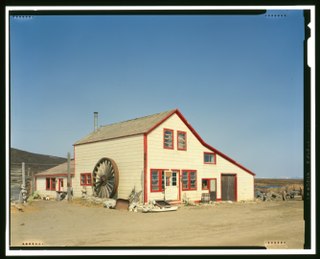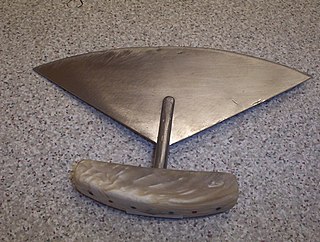Related Research Articles

Eskimo is an exonym used to refer to two closely related Indigenous peoples: Inuit and the Yupik of eastern Siberia and Alaska. A related third group, the Aleut, which inhabit the Aleutian Islands, are generally excluded from the definition of Eskimo. The three groups share a relatively recent common ancestor, and speak related languages belonging to the Eskaleut language family.

The walrus is a large pinniped marine mammal with discontinuous distribution about the North Pole in the Arctic Ocean and subarctic seas of the Northern Hemisphere. It is the only extant species in the family Odobenidae and genus Odobenus. This species is subdivided into two subspecies: the Atlantic walrus, which lives in the Atlantic Ocean, and the Pacific walrus, which lives in the Pacific Ocean.

The Yupik are a group of Indigenous or Aboriginal peoples of western, southwestern, and southcentral Alaska and the Russian Far East. They are related to the Inuit and Iñupiat. Yupik peoples include the following:

Nome Census Area is a census area located in the U.S. state of Alaska, mostly overlapping with the Seward Peninsula. As of the 2020 census, the population was 10,046, up from 9,492 in 2010. It is part of the unorganized borough and therefore has no borough seat. Its largest community by far is the city of Nome.

Gambell(GAM-bull) is a city in the Nome Census Area of the U.S. state of Alaska. Located on St. Lawrence Island, it had a population of 681 at the 2010 census, up from 649 in 2000.

Savoonga is a city in Nome Census Area, Alaska. It is located on St. Lawrence Island in the Bering Sea. As of the 2020 census, Savoonga's population was 835, up from 671 in 2010.

The Iñupiat are a group of Indigenous Alaskans whose traditional territory roughly spans northeast from Norton Sound on the Bering Sea to the northernmost part of the Canada–United States border. Their current communities include 34 villages across Iñupiat Nunaat, including seven Alaskan villages in the North Slope Borough, affiliated with the Arctic Slope Regional Corporation; eleven villages in Northwest Arctic Borough; and sixteen villages affiliated with the Bering Straits Regional Corporation. They often claim to be the first people of the Kauwerak.

Siberian Yupiks, or Yuits, are a Yupik people who reside along the coast of the Chukchi Peninsula in the far northeast of the Russian Federation and on St. Lawrence Island in Alaska. They speak Central Siberian Yupik, a Yupik language of the Eskimo–Aleut family of languages.

St. Lawrence Island is located west of mainland Alaska in the Bering Sea, just south of the Bering Strait. The village of Gambell, located on the northwest cape of the island, is 50 nautical miles from the Chukchi Peninsula in the Russian Far East. The island is part of Alaska, but closer to Russia and Asia than to the Alaskan and North American mainland. St. Lawrence Island is thought to be one of the last exposed portions of the land bridge that once joined Asia with North America during the Pleistocene period. It is the sixth largest island in the United States and the 113th largest island in the world. It is considered part of the Bering Sea Volcanic Province. The Saint Lawrence Island shrew is a species of shrew endemic to St. Lawrence Island. The island is jointly owned by the predominantly Siberian Yupik villages of Gambell and Savoonga, the two main settlements on the island.

The Inuit Circumpolar Council (ICC), formerly Inuit Circumpolar Conference, is a multinational non-governmental organization (NGO) and Indigenous Peoples' Organization (IPO) representing the 180,000 Inuit, Yupik, and Chukchi peoples people living in Alaska, Canada, Greenland, and Chukotka (Russia). ICC was ECOSOC-accredited and was granted special consultative status at the UN in 1983.

An ulu is an all-purpose knife traditionally used by Inuit, Iñupiat, Yupik, and Aleut women. It is used in applications as diverse as skinning and cleaning animals, cutting a child's hair, cutting food, and sometimes even trimming blocks of snow and ice used to build an igloo.
The claim that Eskimo words for snow are unusually numerous, particularly in contrast to English, is often used to support the controversial linguistic-relativity hypothesis or "Whorfianism". The strongest interpretation of this hypothesis, which posits that a language's vocabulary shapes or limits its speakers' view of the world, has been largely discredited, though a 2010 study supports the core notion that these languages have many more words for snow than the English language. The original claim is based in the work of anthropologist Franz Boas and was particularly promoted by his contemporary, Benjamin Lee Whorf, whose name is connected with the hypothesis. The idea is commonly tied to larger discussions on the connections between language and thought.

Prehistoric Alaska begins with Paleolithic people moving into northwestern North America sometime between 40,000 and 15,000 years ago across the Bering Land Bridge in western Alaska; a date less than 20,000 years ago is most likely. They found their passage blocked by a huge sheet of ice until a temporary recession in the Wisconsin glaciation opened up an ice-free corridor through northwestern Canada, possibly allowing bands to fan out throughout the rest of the continent. Eventually, Alaska became populated by the Inuit and a variety of Native American groups. Trade with both Asia and southern tribes was active even before the advent of Europeans.

Chukotsky District is an administrative and municipal district (raion), one of the six in Chukotka Autonomous Okrug, Russia. It is the easternmost district of the autonomous okrug and Russia, and the closest part of Russia to the United States. It borders with the Chukchi Sea in the north, the Bering Sea in the east, Providensky District in the south, and the Kolyuchinskaya Bay in the west. The area of the district is 30,700 square kilometers (11,900 sq mi). Its administrative center is the rural locality of Lavrentiya. Population: 4,995 (2021 Census); 4,838 (2010 Census); 4,541 (2002 Census); 6,878 (1989 Census). The population of Lavrentiya accounts for 30.2% of the district's total population.

Ticasuk Brown (1904–1982) was an Iñupiaq educator, poet and writer. She was the recipient of a Presidential Commission and was the first Native American to have a school named after her in Fairbanks, Alaska. In 2009, she was placed in the Alaska Women's Hall of Fame.

Yup'ik doll is a traditional Eskimo style doll and figurine form made in the southwestern Alaska by Yup'ik people. Also known as Cup'ik doll for the Chevak Cup'ik dialect speaking Eskimos of Chevak and Cup'ig doll for the Nunivak Cup'ig dialect speaking Eskimos of Nunivak Island. Typically, Yup'ik dolls are dressed in traditional Eskimo style Yup'ik clothing, intended to protect the wearer from cold weather, and are often made from traditional materials obtained through food gathering. Play dolls from the Yup'ik area were made of wood, bone, or walrus ivory and measured from one to twelve inches in height or more. Male and female dolls were often distinguished anatomically and can be told apart by the addition of ivory labrets for males and chin tattooing for females. The information about play dolls within Alaska Native cultures is sporadic. As is so often the case in early museum collections, it is difficult to distinguish dolls made for play from those made for ritual. There were always five dolls making up a family: a father, a mother, a son, a daughter, and a baby. Some human figurines were used by shamans.
Susie Paallengetaq Silook is a carver, sculptor and writer, of Siberian Yupik, Inupiaq and Irish descent. She was born in Gambell, Alaska.
Annie Aghnaqa (Akeya) Alowa (née Akeya; also known as, Aghnaqa (Annie Akeya Alowa) and Annie Alowa; 25 June 1924 - 19 February 1999) was a Yup'ik elder and Alaskan environmental activist, healer, and leader in health and justice advocacy for indigenous peoples. Miller founded the Alaska Community Action on Toxics (ACAT). She was inducted into the Alaska Women's Hall of Fame in 2016.
Tom Akeya is an Inuit ivory carver. His work has been sold in multiple places.

Florence Nupok Malewotkuk, also spelled Napaaq Maligutkak, was a Siberian Yupik artist known for her drawings of native Eskimo culture, scenes of local wildlife, and documentation of native tattoos. Her "somewhat naive" style earned her the title of "Grandma Moses of the Bering Sea." She was also a skilled artisan of beaded items such as sealskin Mukluks, toys, and slippers. Nupok's artwork has been exhibited across the United States and is in the permanent collection of institutions including the University of Alaska, the National Museum of the American Indian, the Anchorage Museum of History and Art, and the Smithsonian Institution.
References
- 1 2 3 4 5 6 "Vera Metcalf | Alaska Women's Hall Of Fame". Alaska Women's Hall of Fame. Retrieved 2022-02-05.
- ↑ "NATIVE AMERICAN GRAVES PROTECTION AND REPATRIATION REVIEW COMMITTEE MEETING". National Park Service. October 1995. Retrieved February 6, 2022.
- ↑ "NAGPRA News" (PDF). Common Ground. 1 (1): 44–46.
- ↑ Metcalf, Vera (September 2001). "AKUZILLEPUT IGAQULLGHET: A participants postscript" (PDF). Arctic Study Centers Newsletter. p. 29. Retrieved February 6, 2022.
- ↑ Metcalf, Vera; Krupnik, I, eds. (2003). Pacific walrus. Conserving our culture through traditional management. Report Produced by Eskimo Walrus Commission, Kawerak, under a Grant from the U.S. Fish and Wildlife Service, Section 119 (2003) Cooperative Agreement No. 701813J506.
- ↑ Demer, Lisa (October 4, 2017). "Walruses adapt to loss of sea ice and are not endangered, feds say". Anchorage Daily News. Retrieved 2022-02-05.
- ↑ "Alaska Delegation Introduces Bills to Curb States' Bans on Walrus Ivory". KNOM Radio Mission. 2019-03-26. Retrieved 2022-02-05.
- ↑ Hovey, Davis (2017-06-21). "Confusion over legalities is hurting Alaskan ivory market, locals say". KTOO. Retrieved 2022-02-05.
- ↑ Brulliard, Karin (June 23, 2016). "The grim reason pilots need to worry about walruses". Washington Post. ISSN 0190-8286 . Retrieved 2022-02-05.
- ↑ Khachatoorian, Travis (June 15, 2016). "Feds urge pilots to avoid walrus haulouts to prevent deadly stampedes". Alaska News Source. Retrieved 2022-02-05.
- ↑ Reiss, Bob (March 2010). "Barrow, Alaska: Ground Zero for Climate Change". Smithsonian Magazine. Retrieved 2022-02-05.
- ↑ Haecker, Diane (August 8, 2013). "St. Lawrence Island suffers worst walrus harvest on record" (PDF). Nome Nugget. p. 1. Retrieved February 6, 2022.
- ↑ Milman, Oliver (2016-12-19). "Alaska indigenous people see culture slipping away as sea ice vanishes". the Guardian. Retrieved 2022-02-05.
- ↑ D'Oro, Rachel · (August 6, 2015). "Walrus move north, leaving Alaska natives with fewer food sources". CBC News. p. August 6, 2015. Retrieved February 5, 2022.
- ↑ Deedy, Alexander (2021-09-12). "Alaska Magazine | A Voice for Thousands: Q&A with Vera Metcalf". Alaska Magazine. Retrieved 2022-02-07.
- ↑ "Vera Kingeekuk Metcalf | US Arctic Research Commission" . Retrieved 2022-02-05.
- ↑ "Business People". Anchorage Daily News. 23 October 2006. p. F2.
- ↑ "U.S. and Russia introduce visa-free travel for Chukotka and Alaska". Russia Beyond. 2015-07-23. Retrieved 2022-02-05.
- ↑ Schuessler, Ryan (2015-07-30). "Small thaw in U.S.-Russian relations at the Alaska frontier". Washington Post. ISSN 0190-8286 . Retrieved 2022-02-05.
- ↑ "CHOW Chat: Vera Metcalf on Indigenous Knowledge for our Ocean". National Marine Sanctuary Foundation. Retrieved 2022-02-05.
- ↑ Arthur, Maeve; Neal, Abby (June 19, 2020). "Ocean Partnerships Highlighted during Capitol Hill Ocean Week | Article | EESI". www.eesi.org. Retrieved 2022-02-06.
- ↑ Quinn, Eilís (2019-12-20). "Inuit leaders applaud UN move to designate International Decade of Indigenous Languages". Eye on the Arctic. Retrieved 2022-02-05.
- ↑ "Circumpolar Inuit org looks forward to International Decade of Indigenous Languages". Nunatsiaq News. 2020-01-03. Retrieved 2022-02-05.
- ↑ Naiden, Alena (November 11, 2021). "Changing Arctic: Indigenous and scientific experts unite". www.thearcticsounder.com. Retrieved 2022-02-05.
- ↑ "Before Columbus". ankn.uaf.edu. Retrieved 2022-02-06.
- ↑ "Education Update - 2008 WINGS Women of Discovery Awardees". www.educationupdate.com. March 2008. Retrieved 2022-02-06.
- ↑ "Profile of AK Women's Hall of Fame Inductee: Vera Metcalf". KNOM Radio Mission. 2019-04-30. Retrieved 2022-02-05.
- ↑ Mason, James (2019-05-10). "Nome's Vera Metcalf inducted into Alaska Women's Hall of Fame". The Nome Nugget. Retrieved 2022-02-06.